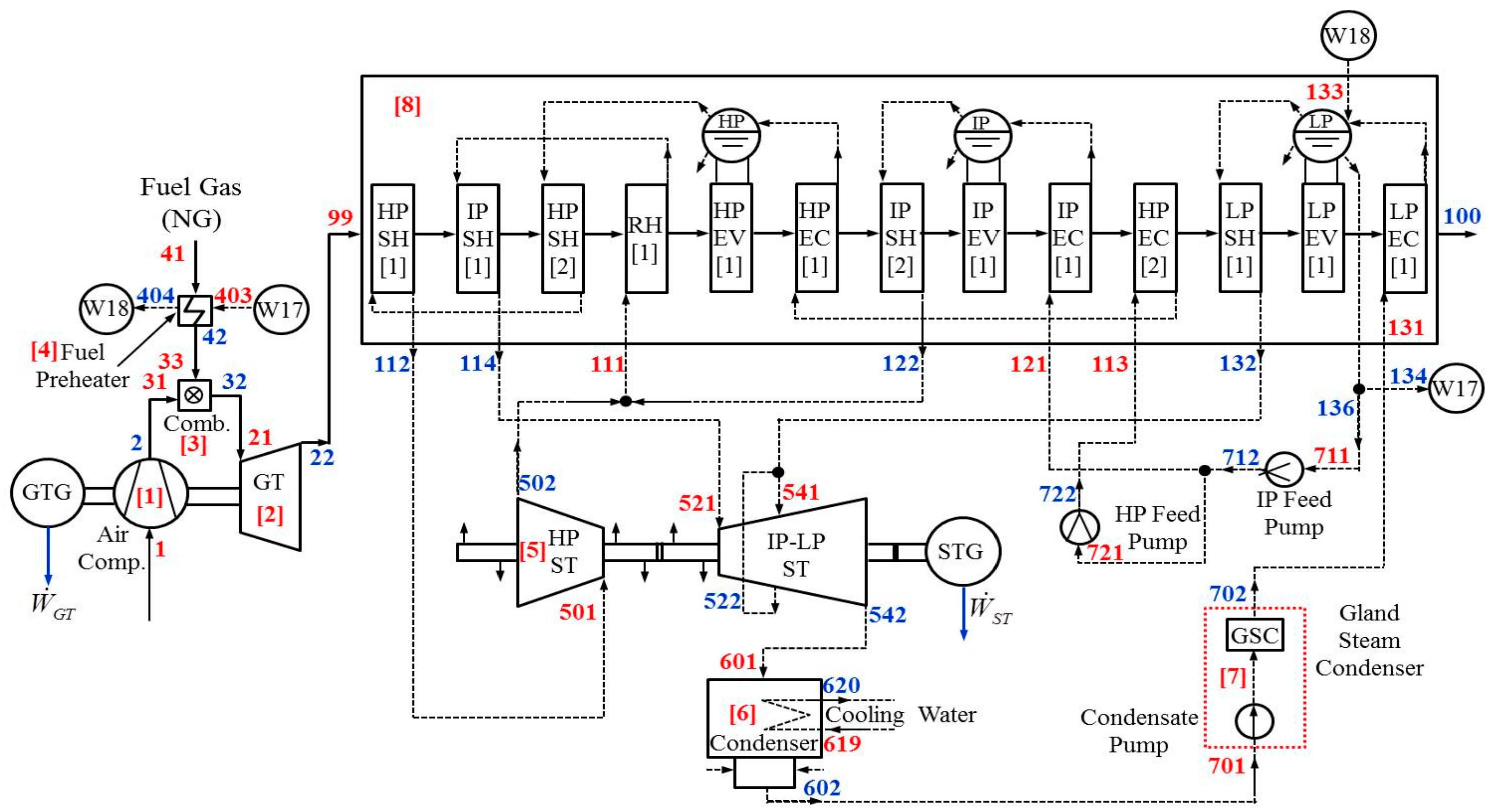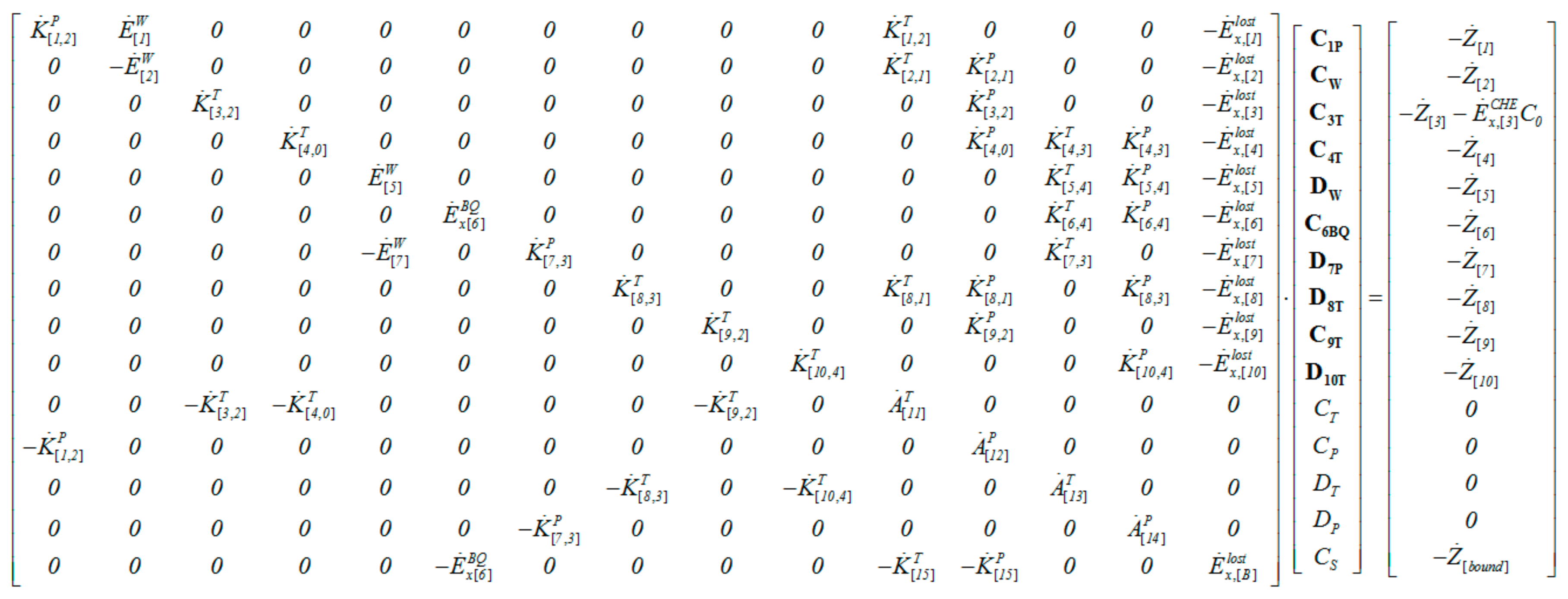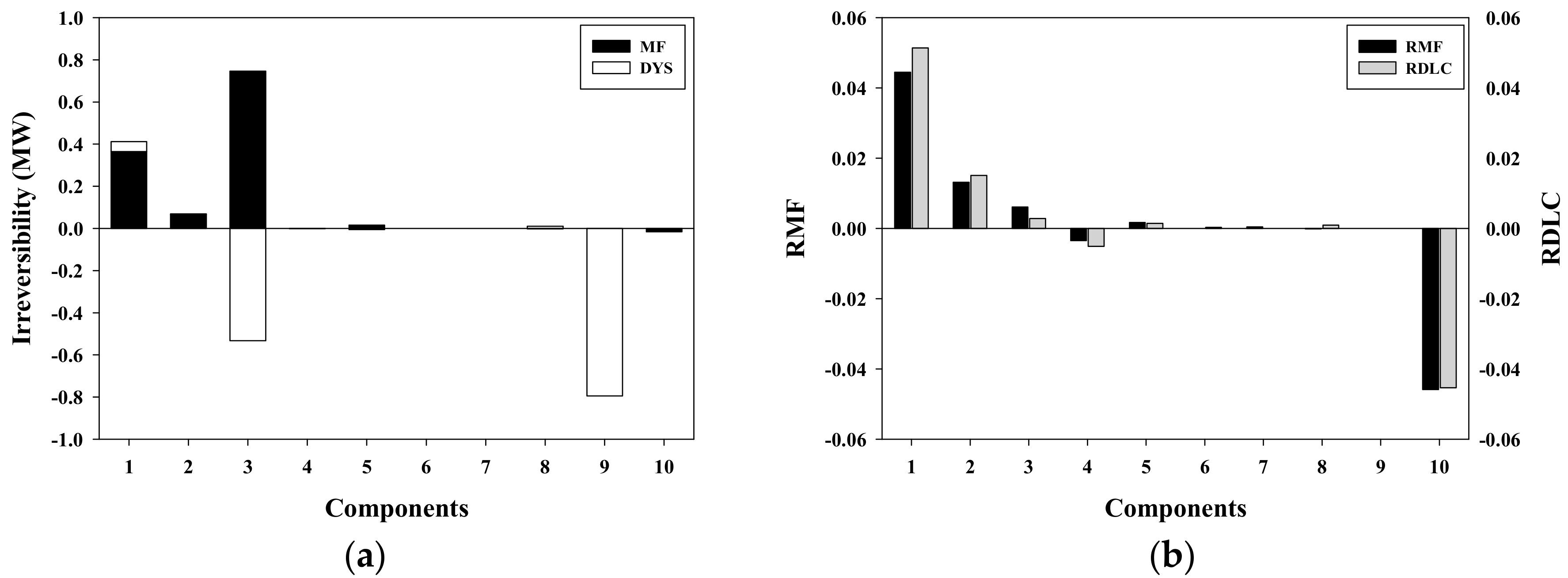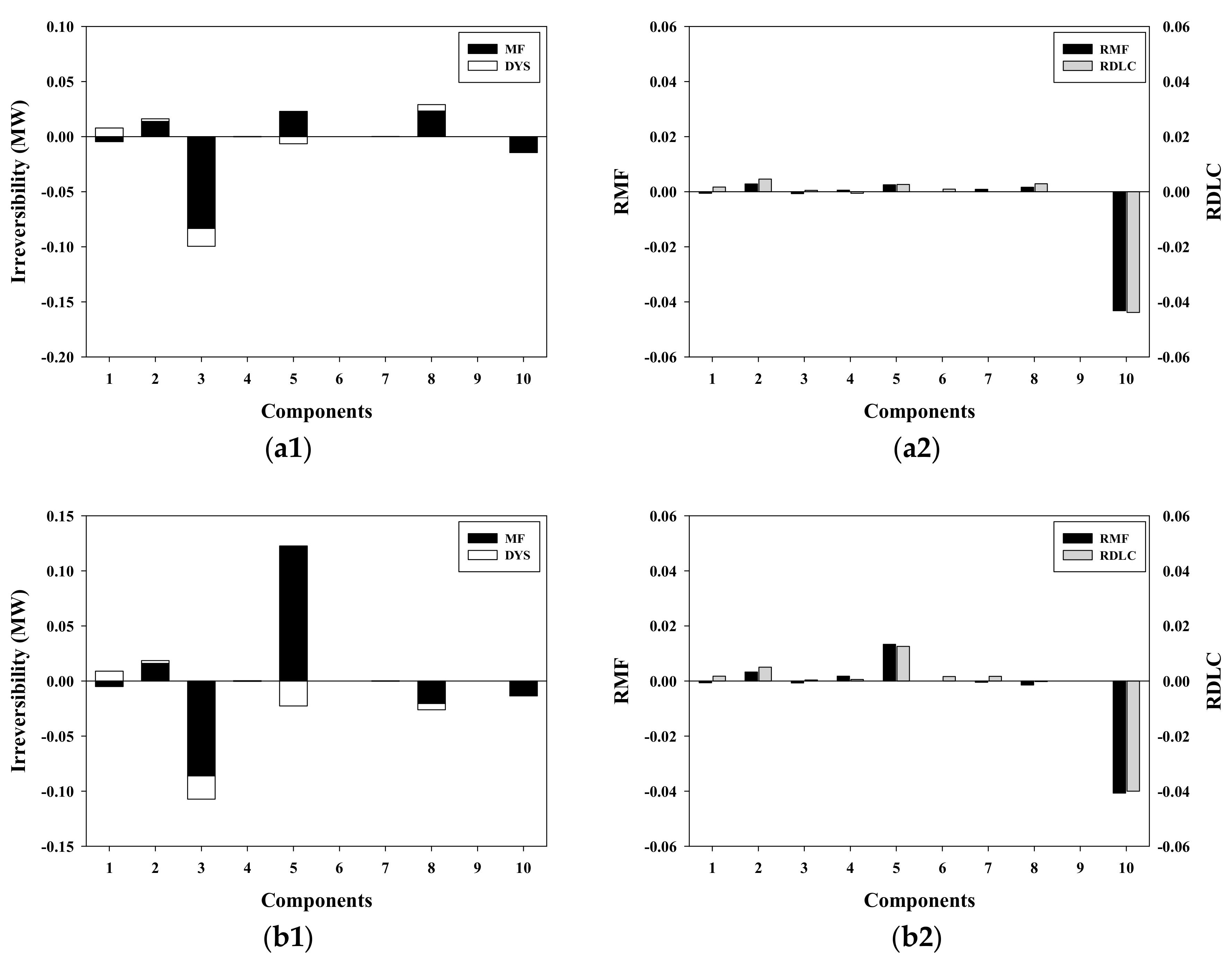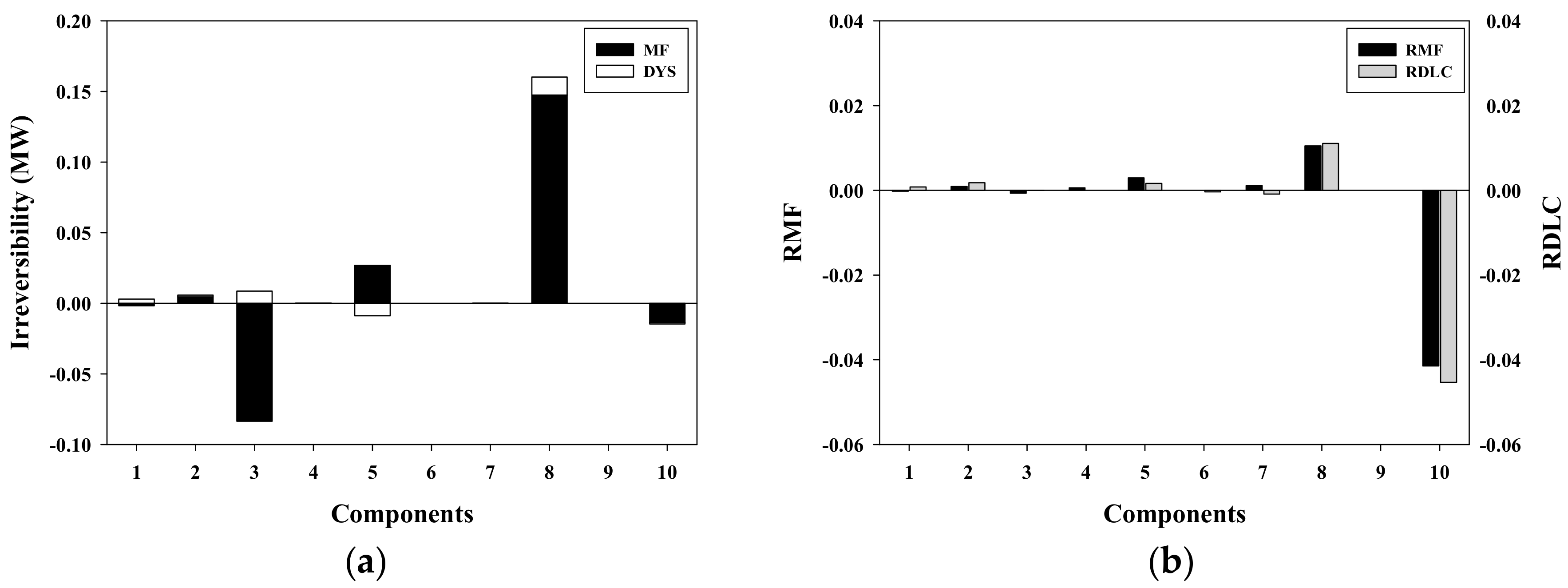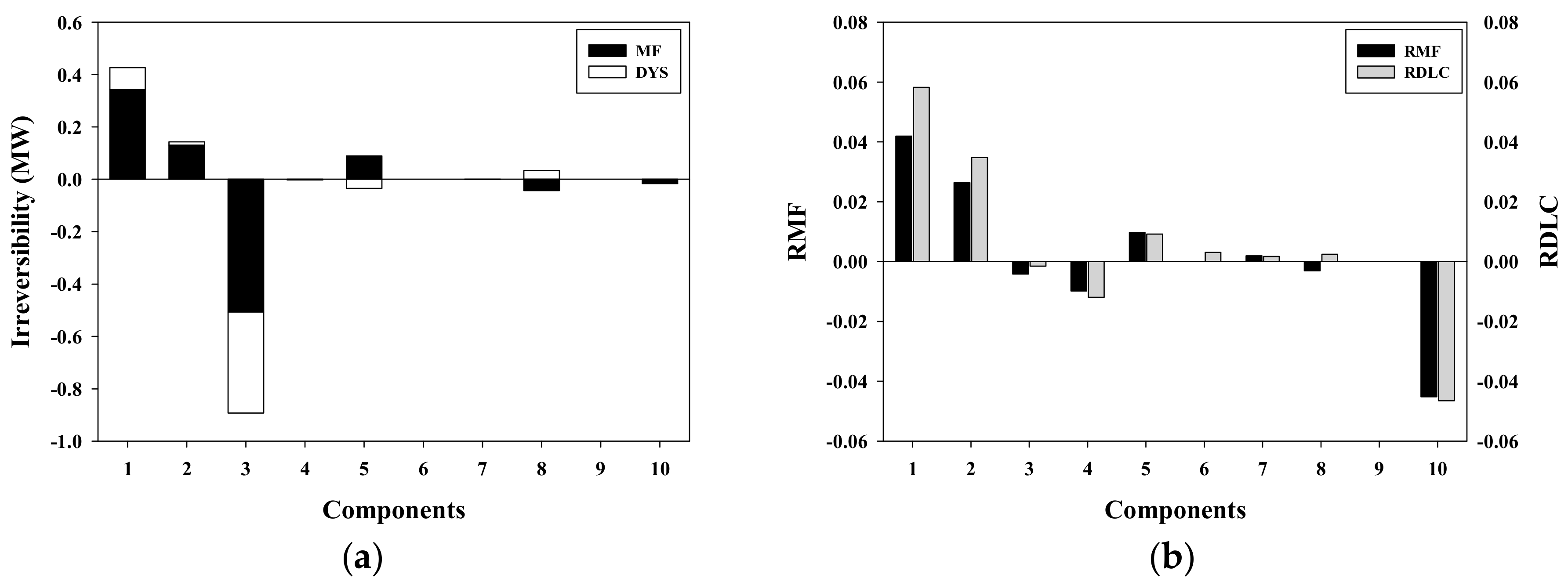1. Introduction
The performance of a power plant deteriorates during operation due to degradation in plant components. Common causes of degradation in power plants include fouling of heat exchangers in steam generators and corrosion and/or erosion that occurs in compressors and turbine blades. Degradation in a component results in changes in the thermodynamic properties at the entrance/exit points of the components, performance of the components and system and the cost of products of the system. When degradation occurs in a component, it is necessary to perform maintenance of the component to improve the performance of the plant. However, identification of a malfunctioning component is not a simple task when the deviation is less than 3%, which cannot be detected by the operator [
1]. Furthermore it is not feasible to detect the components when anomalies occur simultaneously, because the interaction between components is very complex.
Diagnosis of power plants corresponds to the detection of malfunctioning components, identification of the causes of the malfunction, and the quantification of the malfunction [
2]. Thermoeconomics, which combines the thermodynamics concept of exergy with economic principle, quantifies the exergy destruction and the corresponding monetary loss occurred at each component in power plants [
3]. Such merits of thermoeconomics which quantifies the exergy destruction due to the entropy generation and the corresponding lost cost depending on the degree of malfunction make it possible to apply to diagnosis of energy systems. A possible application of thermoeconomics to diagnose a power system was first suggested by Lozano et al. [
4] and Valero et al. [
5]. A feasibility of the diagnosis of a power plant based on thermoeconomic analysis was provided by Correas et al. [
6]. Further development of the thermoeconomic diagnosis which clarified the intrinsic and induced malfunction and determined the cost generated by the malfunction in degraded components was undertaken by Verda et al. [
7,
8], Torres et al. [
9], and Valero et al. [
10]. A characteristic curve method to locate and categorize malfunctions was proposed by Lazzaretto and Toffolo [
11] and Toffolo and Lazzaretto [
12]. Thermoeconomic diagnosis was applied to evaluate the performance degradation of coal-fired power plants [
13]. Recently, two thermoeconomic diagnosis methods were applied to a combined cycle plant [
14] and refrigerant system [
15,
16]. The conventional thermoeconomic diagnosis for air conditioning unit yields promising results for evaporator fouling. However, it does not provide reliable results for condenser fouling [
16]. Cziesla and Tsatsaronis [
17] performed exergoeconomic assessment of the performance degradation in a coal-fired steam power plant by using the unit cost of product in components as an indicator to identify malfunctioning components. Energy efficiency diagnosis is a mature tool in power plant operation and management at present [
18,
19]. However, advanced monitoring and diagnosis techniques based on thermoeconomics [
20] are required and should be developed.
In the present study, a modified productive structure analysis (MOPSA) [
3] method that provides irreversibility due to entropy generation and it allocates a lost cost flow rate for each component was applied to simulate the performance degradation due to the pre-fixed malfunctioning components for a conventional 300-MW combined cycle power plant (CCPP) at 100% load. Thermodynamic properties, such as temperatures, pressures and mass flow rates for the power plant with pre-fixed malfunction components were estimated using the GateCycle
TM energy balance software. Multi-fault scenarios that can be detected by the indicators were also considered. The relative malfunction (RMF) and the difference in the lost cost flow rate between real operation and reference conditions (RDLC) were used as indicators for the identification of malfunction components. Calculation results indicate that thermoeconomic diagnosis method presented in this study could allow detecting the faulty components in the plant and evaluate the added cost while the plant is still functional.
2. Cost-Balance Equations for a 300-MW Combined Power Plant
2.1. Modified Productive Structure Analysis (MOPSA) Method [3]
A general exergy-balance equation applicable to any component of thermal systems may be formulated by utilizing the first and second law of thermodynamics [
21]. The general exergy-balance equation for the
k-th component may be written as:
where
and
denote the rate of exergy and entropy flows, respectively, in the plant, and
in the fifth term denotes the heat transfer interaction between a component and the environment. Assigning a unit exergy cost to every decomposed exergy stream, the cost-balance equation corresponding to the exergy-balance equation for the
k-th component is given by [
3].
where
C denotes the unit cost exergy and
CHE,
BQ,
T,
P,
W used as the superscripts in Equation (1) and subscripts in Equation (2) denote chemical, steam, thermal, mechanical and work or electricity, respectively. The term
includes all financial charges associated with owning and operating the
k-th plant component. In this study the steam exergy is decomposed into thermal and mechanical exergies. The exergy costing method based on Equations (1) and (2) is called MOPSA in the sense that these equations yield the productive structure of the thermal systems. The MOPSA method can systematically handle any complex power plant [
22,
23] and provide the correct unit cost of products for coal-fired power plants [
23]. Furthermore, the MOPSA method provides the irreversibility and the lost cost rate due to the entropy production rate in each component in the power plants. Thermal and mechanical exergies and negentropy, play very important roles as internal parameters to calculate the unit cost of various exergies. On the other hand, the MF and DYS method based on the conventional thermoeconomic theory [
9] is an upstream analysis of the productive process, which needs difficult and elaborate calculations. Specifically, the total negentropy generated in all components appears as a principal product for the “system boundary”, with a positive sign.
2.2. Levelized Cost of a Plant Component
The costs of owning and operating a plant depend on several factors, including the type of financing, required capital, and expected life of a component. The annualized (levelized) cost method [
24] is used in the present study. The amortization cost for a particular plant component is written as follows:
The salvage value at the end of the
n-th year is taken as 10% of the initial investment for component
Ci. The present worth of the component is converted to the annualized cost by using the capital recovery factor CRF (
i,
n), as follows:
The levelized cost is divided by 8000 annual operating hours to obtain the following capital cost rate for the
k-th component of the plant:
The maintenance cost is considered through the factor for each plant component.
2.3. 300-MW CCPP
In
Figure 1, a schematic representation of a 300-MW CCPP system that is used as a reference plant shows every state point that was accounted for in the analysis. The schematic shows the following eight components: (1) air compressor (AC), (2) gas turbine (GT), (3) combustor (COM), (4) fuel preheater (FP), (5) steam turbine (ST), (6) condenser (CON), (7) pump (PP), and (8) heat recovery steam generator (HRSG). The mass flow rates of fuel, air and steam (or water) and temperature and pressure data at the state points in the 300-MW power plant, which were provided by an electric company in Korea are shown in
Table 1. The entropy and thermal and mechanical exergy flow rates were calculated using the data. A detailed calculation was separately performed for the heat exchangers in HRSG by considering the energy loss in the components.
2.4. Cost-Balance Equations for Each Component in a 300-MW CCPP
The cost-balance equations for each component in the CCPP, shown in
Figure 1 can be derived from the general cost-balance equation given in Equation (2). A new unit cost must be assigned to the component’s principal product when the cost-balance equation is applied to a component, and its unit cost is expressed as a Gothic letter. For example, an air compressor is a component that uses electricity to increase the mechanical exergy of air. The method assigns a new unit cost of
C1P to the mechanical exergy of air, the component’s main product. After the unit cost is assigned to the respective principal product of a component, the cost-balance equations and the corresponding short hand notation for the cost-balance equations for these components are as follows:
- (1)
- (2)
- (3)
- (4)
- (5)
- (6)
- (7)
- (8)
Heat recovery steam generator (HRSG)
- (9)
- (10)
As shown in Equation (13), the water and steam exergy streams, entering or leaving the HRSG were considered. The heat losses and pressure drops inside pipes in which gases and water or steam flows were considered in Equations (9) and (10), respectively, by assuming that the gas and steam pipes are real components in the system. This concept is necessary for perfect exergy and cost balance of the plant. Ten cost-balance equations from the ten components of the combined plant were derived, with 15 unknown unit exergy costs, namely, C1P, CW, C3T, C4T, DW, C6BQ, D7P, D8T, C9T, D10T, CT, CP, DT, DP and CS. We obtain four more cost-balance equations for the junctions of the thermal and mechanical exergies for gas and steam streams. These four cost-balance equations and the corresponding short-hand notation equations are given as follows:
Another cost-balance equation is obtained, corresponding to the exergy balance for the plant boundary of the combined cycle plant. The cost-balance equation for the system boundary is given as follows:
The overall cost-balance equation is obtained by adding all the cost-balance equations of the components and boundary of the system. The overall cost-balance equation for the plant that may be considered as the first principle in thermoeconomics, is given in previous study [
3] as follows:
During the addition of exergy-balance equation of components, the terms related to the unit cost of mechanical energy CP, the thermal exergy CT for gases, the unit cost of mechanical exergy DP, thermal exergy DT for steam, and negentropy CS disappear such that the cost-balance equation for the entire system does not include the aforementioned terms.
The matrix representation of the all cost-balance equations for the CCPP system is shown in
Figure 2. Each row in the matrix represents the exergy-balance equation for a component or junction and the diagonal element indicates the principal product for each component. The exergy-balance equation for junction represents a “junction” for the specified exergy. On the other hand, each column in the matrix shows the manner in which an exergy produced in a component (diagonal element) is distributed to or consumed in other components (off diagonal elements). In this sense, the diagonal element in each column represents a “node” in the productive structure for the power plant. For example, the GT interacts with the AC through electricity and mechanical exergy. The thermal exergy produced in the COM and added in the FP (
) is consumed in the GT to produce electricity (
) and in the HRSG to increase the exergy of steam (
). This implies that a fault that occurred in the GT affects the performance of the AC, COM, FP, and HRSG. The pressure exergy gained in the AC (
) is consumed in GT (
) and dissipated in COM (
) and HRSG (
). The lost exergy recovered at the boundary (
), which represents the total exergy lost in the system, is distributed among all components (
). Subsequently, the total lost cost is allocated to all components in a manner proportional to the amount of the exergy lost. These examples indicate how the components in the plant are related with each other. Summation of all terms in column yields Equation (21), the overall cost-balance equation. As explained above,
Figure 2 shows clearly the productive structure of the 300-MW CCPP.
3. Exergy and Thermoeconomic Analyses at a Reference Condition and Identification of Malfunctioning Components
The thermal, mechanical exergy flow rates and entropy flow rates at a reference condition and at 100% load for 300-MW CCPP are shown
Table 1. The flow rates were calculated based on the properties such as pressure, temperature, and mass flow rates at various points, which were supplied by a power company. The net flow rates of the various exergies crossing the boundary of each component in the CCPP at the reference condition are shown in
Table 2. The unit cost value of fuel,
$0.02/MJ, was used in the calculation. Positive values of exergies indicate the exergy flow rate of “products” while negative values represent the exergy flow rate of “resources” or “fuel”. The irreversibility in each component acts as a product in the exergy-balance equation. The sum of the exergy flow rates of products and resources is equal to zero for each component and for the entire plant, and this indicates that perfect exergy balances are satisfied.
The mathematical expression of the exergy-balance for each component, as shown in Equation (1) can be rewritten as follows:
where the superscripts
F and
P denote fuel and product for
i-th component, respectively. For example, each term in Equation (22) in AC is given as follows:
Let
ri denote the ratio of the fuel exergy to the product exergy in
i-th component, as follows:
Substituting Equation (23) into Equation (22), the irreversibility that occurs at the
i-th component can be expressed in terms of the exergy product for the component as follows:
The irreversibility difference between real operation and the reference conditions in the
i-th component is expressed as follows [
10,
25]:
where:
The malfunction (MF) defined in Equation (26) represents the endogenous irreversibility, which is produced by an increase in fuel consumption and the dysfunction (DYS) defined in Equation (27) represents the exogenous irreversibility, which is induced in the component by the malfunction of other components [
10]. The MF that does not depend on the mass flow rate of material stream may be selected as one of the indicators to identify the faulty components [
10,
16]. The DYS is not appropriate for the indicators because the MF only affects the behavior of components [
10]. One of the most useful methods to quantify the effects of the intrinsic malfunctions is MF [
15]. Previously Δ
I and Δ
I/
I were considered as indicators for evaluation of malfunction in the components [
25].
Relative malfunction (RMF) may be defined as the ratio of the MF to the irreversibility that occurs at the reference condition, as follows:
At the very least, the induced malfunction due to the change in the mass flow rate is eliminated in this particular condition. The dysfunction induced by change in the mass flow rate is obtained by the following equation:
where:
The dysfunction modified by eliminating the induced malfunction defined in Equation (29) is as follows:
In fact, the main difficulty in the application of thermoeconomics to the diagnosis of power plant is the presence of the induced malfunctions in the components [
19] so that the correct diagnosis consists of successive filtration of the induced effect [
26].
Table 3 lists the initial investments, the annuities including the maintenance cost, as well as the corresponding monetary flow rates for each component. The total construction cost that, comprises the cost of land, site preparation, and building construction, are also input into the cost calculation in the “boundary” component. The cost of CO
2 emission, which is proportional to carbon content relative to the heating value of fuel spent in the power plant, may be included in fuel cost. The cost flow rates corresponding to a component’s exergy flow rate and the construction cost at the 100% load condition are specified in
Table 4. The same sign convention for the cost flow rates related to the products and resources was used as the case of exergy balances shown in
Table 2. However, the lost cost flow rate due to the lost work in a component is consumed cost or input cost [
27]. Certainly, the lost cost is not a production cost [
17]. As shown in
Table 4, the sum of the cost flow rates of each component in the plant is zero, and thus the cost balance for each component given in Equation (2) is rewritten as follows:
where the superscripts
F and
P denote fuel and product for the
i-th component, respectively. The lost cost flow rate due to the irreversibility is added as a cost to the component. For example, each term in Equation (31) in AC is given as follows:
The lost cost flow rate encountered in Equation (31) is considered as the cost flow rate of residues [
27] if the cost flow rates are proportionally allocated to the entropy generation rate [
28]. In the MOPSA method, the same unit cost of negentropy is assigned irrespective of material streams and flow conditions [
3].
The difference of the lost cost flow rate between real operation and reference conditions, or the additional lost cost flow rate, can be obtained from Equation (29) by assuming that the capital flow rate for the component does not change. That is expressed as follows:
It is convenient to introduce the relative difference of the lost cost flow rate between real operation and reference conditions (RDLC), which is defined as follows:
The above parameter, RDLC, is utilized as an indicator to identify the malfunctioning component.
The degree of influence on the
j-th component due to the fault in the
i-th component in terms of the RDLC and MF values is defined as follows:
